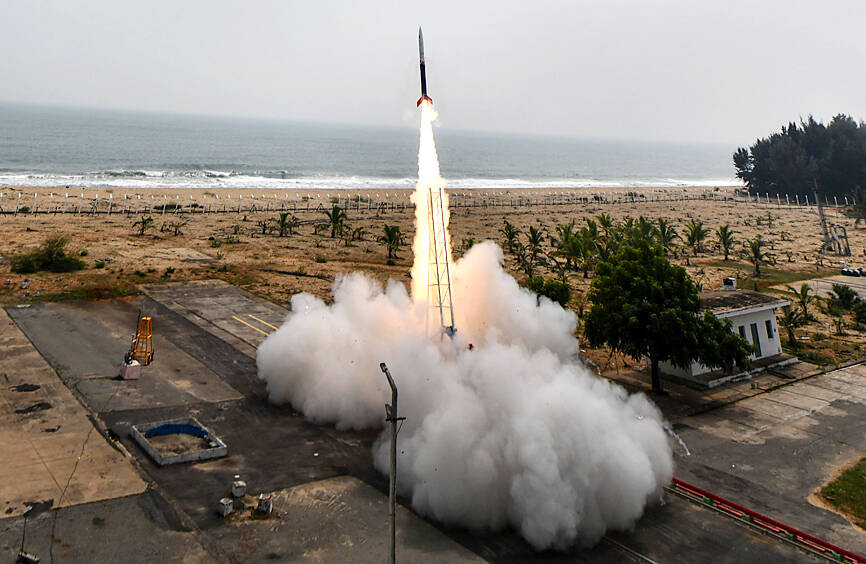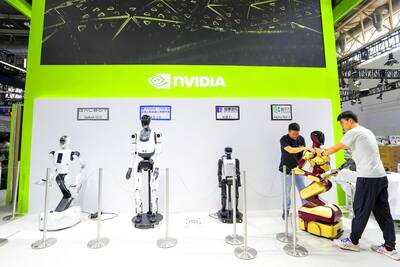The start-up behind India’s first private space launch plans to put a satellite into orbit next year, and expects to be able to do so at half of the cost of established launch companies, the founders of Skyroot Aerospace said.
The Hyderabad-based company, backed by Singapore’s sovereign wealth fund, GIC, said the US$68 million it has raised would fund its next two launches, adding that it has been in contact with more than 400 potential customers.
Thousands of small satellite launches are planned in coming years as companies build out networks to deliver broadband services such as SpaceX’s Starlink and to power applications like tracking supply chains or monitoring offshore oil rigs.

Photo: EPA-EFE
Skyroot faces established and up-and-coming rocket launch rivals that also promise to bring down costs. In China, start-up Galactic Energy put five satellites into orbit last week in its fourth successful launch.
In Japan, Space One, backed by Canon Electronics and IHI Corp, plans to launch 20 small rockets per year by the middle of the decade.
Skyroot, which launched a test rocket last week, expects to cut the cost of a launch by 50 percent compared with current pricing for established competitors such as Richard Branson’s Virgin Orbit and California-based Rocket Lab USA Inc.
Pawan Chandana, one of Skyroot’s two cofounders, said he expected a surge in demand for the company’s launch services if it proves itself with launches set for next year.
“Most of these customers have been building constellations and will be launching them in the next five years,” he said.
A push by Indian Prime Minister Narendra Modi’s administration to increase India’s share of the global space launch market from just 1 percent has given investors confidence that Skyroot and other start-ups have government backing for their efforts, Skyroot said.
“Three or four months back when we were talking to investors, one of the biggest questions they asked was if the government was supporting us,” Skyroot cofounder Bharath Daka said.
India opened the door to private space companies in 2020 with a regulatory overhaul and a new agency to boost private-sector launches.
Before that, companies could only act as contractors to the Indian Space Research Organisation (ISRO), a government space agency with a reputation of its own for frugal engineering. The country’s Mars mission in 2014 cost only US$74 million, less than the budget of the Hollywood space movie Gravity.
Building on India’s record for cost efficiency would be key, Chandana said.
Skyroot, founded in 2018 when Chandana and Daka quit jobs at ISRO, has set a target to develop rockets for one-fifth of the current industry costs.
The Skyroot rocket that reached 89.5km altitude in last week’s test launch used carbon-fiber components and 3D-printed parts, including the thrusters.
That boosted efficiency by 30 percent, cutting weight and procurement costs, although it meant Skryoot engineers had to write the machine code for vendors who fabricated the rocket because few had experience working with carbon fiber, the company said.
With 3D printing, Skyroot believes it can build a new rocket in just two days as it works towards reusable rockets, a technology pioneered by SpaceX.
Chandana and Daka believe the per-kilogram launch cost for a satellite can be brought down to nearly US$10, from thousands of dollars currently, a stretch target that could upend the economics of space commerce and one that draws inspiration from their idol: SpaceX CEO Elon Musk.
“SpaceX is a symbol of great innovation and great market validation,” Chandana said, adding that they have not had the chance to speak to Musk.
“Right now, we think he’s probably busy running Twitter,” he said.

UNCERTAINTIES: Exports surged 34.1% and private investment grew 7.03% to outpace expectations in the first half, although US tariffs could stall momentum The Chung-Hua Institution for Economic Research (CIER, 中華經濟研究院) yesterday raised its GDP growth forecast to 3.05 percent this year on a robust first-half performance, but warned that US tariff threats and external uncertainty could stall momentum in the second half of the year. “The first half proved exceptionally strong, allowing room for optimism,” CIER president Lien Hsien-ming (連賢明) said. “But the growth momentum may slow moving forward due to US tariffs.” The tariff threat poses definite downside risks, although the scale of the impact remains unclear given the unpredictability of US President Donald Trump’s policies, Lien said. Despite the headwinds, Taiwan is likely

When Lika Megreladze was a child, life in her native western Georgian region of Guria revolved around tea. Her mother worked for decades as a scientist at the Soviet Union’s Institute of Tea and Subtropical Crops in the village of Anaseuli, Georgia, perfecting cultivation methods for a Georgian tea industry that supplied the bulk of the vast communist state’s brews. “When I was a child, this was only my mum’s workplace. Only later I realized that it was something big,” she said. Now, the institute lies abandoned. Yellowed papers are strewn around its decaying corridors, and a statue of Soviet founder Vladimir Lenin

UNIFYING OPPOSITION: Numerous companies have registered complaints over the potential levies, bringing together rival automakers in voicing their reservations US President Donald Trump is readying plans for industry-specific tariffs to kick in alongside his country-by-country duties in two weeks, ramping up his push to reshape the US’ standing in the global trading system by penalizing purchases from abroad. Administration officials could release details of Trump’s planned 50 percent duty on copper in the days before they are set to take effect on Friday next week, a person familiar with the matter said. That is the same date Trump’s “reciprocal” levies on products from more than 100 nations are slated to begin. Trump on Tuesday said that he is likely to impose tariffs

READY TO BUY: Shortly after Nvidia announced the approval, Chinese firms scrambled to order the H20 GPUs, which the company must send to the US government for approval Nvidia Corp chief executive officer Jensen Huang (黃仁勳) late on Monday said the technology giant has won approval from US President Donald Trump’s administration to sell its advanced H20 graphics processing units (GPUs) used to develop artificial intelligence (AI) to China. The news came in a company blog post late on Monday and Huang also spoke about the coup on China’s state-run China Global Television Network in remarks shown on X. “The US government has assured Nvidia that licenses will be granted, and Nvidia hopes to start deliveries soon,” the post said. “Today, I’m announcing that the US government has approved for us